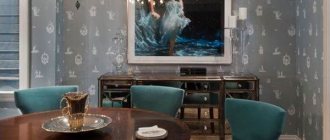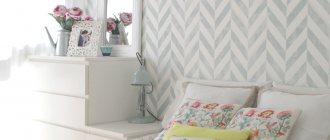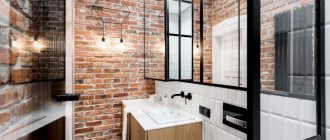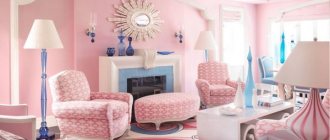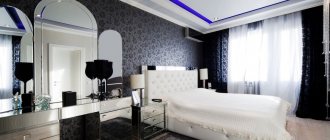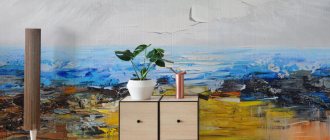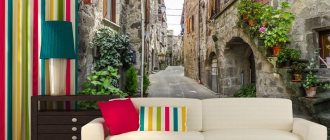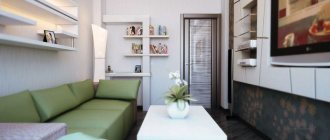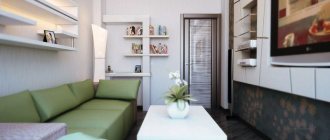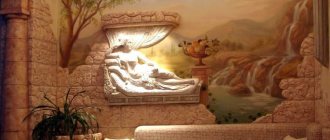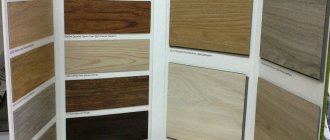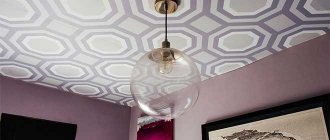Modern wallpapers, what are they?
Wallpaper for a living room should convey a certain message, especially since a huge selection of materials of various textures and colors contributes to this.
- Paper wallpaper has long moved from the budget niche to the premium segment. Foreign manufacturers offer interesting options with modern prints; plant themes, herbariums, and complex geometric patterns are in fashion. A special place is occupied by paper wallpaper with voluminous figured embossing and photo wallpaper with a 3D effect.
- Non-woven wallpaper allows you to create an ideal surface with a complex pattern on which you will never find seams, since the wallpaper is glued end to end. This type of wallpaper is as environmentally friendly and safe as paper wallpaper. They allow air and moisture to pass through, maintaining a healthy microclimate in the room.
- Textile, metallized, glass wallpaper, liquid wallpaper are new materials that allow you to create a unique interior that emphasizes the individuality of the owners of the house.
Wallpaper selection
The most important thing: do not buy cheap wallpaper with designs and patterns. This is the worst thing you can do - the print quality on them is always terrible and it shows. If your budget is very limited, take plain wallpaper without patterns or patterns, they are quite normal. Just compare expensive and cheap wallpapers, and if this is visible even in the photo, imagine what it looks like in real life.
In this material we will talk about wallpaper for modern styles.
When choosing wallpaper, first of all you should pay attention to its surface - smooth or textured. In 2022, the variety of wallpapers, both in appearance and price, is simply enormous. But we will only talk about options up to $20/meter, because... There’s simply no point in paying more for wallpaper, because for that money you could already take a closer look at decorative plaster:
Wallpaper is objectively worse than decorative plaster and it cannot compete in the same niche. Therefore, we must understand why we choose wallpaper, and there are 2 reasons:
- This is the most budget-friendly finishing option. Wallpaper is inexpensive, gluing it is simple and cheap, and wallpaper does not require perfect preparation of the walls.
- The right patterns, designs, complex color schemes can only be realized this way (that’s why wallpaper is used even in the kitchen).
Here are a few photo examples where it would be impossible to achieve such an effect with anything other than wallpaper:
Hence the conclusion: it makes sense to choose plain wallpaper and wallpaper with interesting geometric and color patterns. It is about their combinations in the interior that we will talk. We repeat, we are talking only about modern styles, there is freedom in the classics for wallpaper, read about classic wallpaper in the material about the bedroom.
Materials
When combining wallpaper, you can experiment not only with colors, but also with different materials. There are matte, glossy, velvety wallpapers.
If you use coatings from different materials, but in the same color scheme, you can create a wonderful interior design.
Among the most popular materials are:
- Paper. A budget option is smooth single-layer wallpaper, but it is very difficult to work with. When water gets on the paper, they can tear easily. This is not very convenient when combining different parts. Due to the thin material, all defects will be visible on the wall.
The most suitable option is multi-layer duplex or triplex wallpaper. Their cost is slightly higher than the price of single-layer ones, but they also remain affordable for the average buyer. Such coatings hide minor imperfections on the walls. Their only drawback is that they quickly fade in the sun and tear easily.
- Vinyl. These wallpapers are made of paper or non-woven backing. Thanks to a variety of vinyl application techniques, the end result is many interesting models. Silk-screen wallpaper or heavy vinyl coverings are ideal for sleeping areas.
If the walls in the bedroom are smooth, then you can glue silk-screen materials. They look very solemn. A slight shine will be noticeable even in the dark; it resembles the shine of natural silk fabrics.
A significant drawback of such wallpaper is the heavy air in the room. Due to the vinyl waterproof film, the walls practically do not breathe. However, the problem can be completely resolved if you regularly ventilate the room or install ventilation in it.
- Non-woven. This wallpaper is made from non-woven material made from cellulose and chemical fibers. Vinyl or other decorative coating is applied to the non-woven base.
Non-woven fabrics are very durable, elastic and convenient for pasting walls. The technology is as simple as possible. A special glue is applied to dry wallpaper that does not corrode the surface. After this, the canvases are easily fixed on a vertical plane.
Due to the high density of the material, they look great even on uneven walls.
Such models are wide meter rolls. For large rooms this is very convenient; fewer joints are formed. It will be more difficult with small rooms. To avoid problems with joining the drawing, it is better to call a specialist who will minimize the likelihood of defects during the work.
Another disadvantage of non-woven wallpaper is its high price. However, it fully justifies itself due to the complex production technology and expensive fibers in the composition. By paying once, the apartment owner will not have to worry about the condition of the walls for many years.
- Textile. Wallpapers of this type are not available to everyone. They are often classified as luxury. They are made from a non-woven base and natural fabrics: jute, linen, cotton, velor or silk.
Hard fibers from flax and jute are embodied in fabrics that resemble matting. Fleecy wallpaper is made of velor or felt. Woven fabrics are produced in the form of very wide rolls, using which you can cover one entire wall in one go. This is very convenient because you don’t have to join different edges.
When combining, choose textile wallpaper from the same material, but in different colors. For example, the silky base is presented in a wide spectral range. However, the combination of different parts will not be carried out on one wall, but throughout the entire space of the room.
Textile fabrics have two significant disadvantages - high cost and problematic maintenance. For example, velor surfaces accumulate a lot of dust, which is difficult to remove from the walls. Please note that wet cleaning is not suitable for textile wallpaper. For many, all these shortcomings are compensated by the aesthetic appeal of these coatings.
- Photo wallpaper. Such canvases are very often used in the combined technique of gluing walls. The photograph can be applied to a paper, vinyl or non-woven base. The quality of the final product will depend on the base. There are special workshops that produce custom photo wallpapers.
A wall with photo wallpaper is always the main accent in the room. The remaining walls are a neutral background.
It is done in neutral (often pastel) colors. The ideal composition is when the background wallpaper is matched to the color of one of the details in the photo.
If the photographic canvas is placed above the sleeping place, then the furniture must be selected to match the tone of this wallpaper. Then the interior will look very harmonious and holistic.
Styles
It is important to select combined wallpapers in accordance with the overall style of the apartment. This is quite difficult to do, because manufacturers are somewhat behind fashion trends. But there is a way out: if you know the features of design trends, in which the main thing is to get into the right color scheme.
- Classical.
Classics always gravitate towards combinations of simple and complex elements. In the case of wallpaper, it can be plain canvases in nude tones (beige, milky, light brown), appliqué on the central wall in the form of vertical stripes or large stucco molding. But the accent surface should be three to four shades darker than the background walls. An excellent option would be a horizontal combination - in combination with moldings or finishing frames around the perimeter. Geometric prints in rich colors can alternate with light inserts.
- High tech. This style to some extent incorporates the features of minimalism. There is no bright palette or elaborate patterns here; warm colors are also not welcome. When it comes to decorating a bedroom, some designers add subtle elements, combining them with cool shades.
- Typically, high-tech is based on white, gray, dark blue and black colors. The background color for the bedroom will be white, and the dominant color will be black. Occasionally, wallpaper can be supplemented with discreet designs. For this option, monochrome canvases are better suited.
- Provence and country. This style is dominated by delicate pink, blue or brown tones. A distinctive feature is a small floral pattern or stripe.
The emphasis is on the bedside area, where the patterned fabric is placed. There is an option with different types of stripes - wide ones are combined with narrow ones. But the color of the wallpaper should be the same.
It is in Provence and country styles that a patchwork combination is used.
Often there are also interiors stylized as stone or wood. In this case, non-woven wallpaper or textile coverings are purchased.
- Oriental. Combined wallpaper in an oriental style is rarely used, but this design idea looks simply gorgeous. The most expensive materials made from natural fibers are combined here (in a bright palette). Red, yellow, orange and burgundy shades predominate.
This style differs from others in that there are practically no pastel colors in the composition. The main and background wallpapers are made in dark colors. The central canvas can be the same color as the rest, but with ornate patterns.
Photo wallpapers are practically not used in oriental style. Textile fabrics are usually welcome here.
Drawing
Both clothing design and wallpaper design are subject to fashion trends, but trends change less often. Fashionable wallpaper for a living room in a modern interior is an abstract pattern, complex interweaving of lines that form an intricate pattern.
For interiors in a classic style - these are monograms on a dark contrasting background or a floral pattern. For a room with an eco-friendly interior, wallpaper with images of trees, exotic birds on the branches, stylized flowers, buds and leaves is suitable.
Fashionable wallpaper for the hall in 2022 often features images of a fern or palm tree leaf, and ornaments with Turkish motifs. Photo wallpapers with macro photography and wallpapers that imitate brickwork remain in fashion.
Wallpaper color in the interior - the most popular and fashionable colors
There are many wallpaper patterns and themes available in the market. Everyone will definitely find a model that is suitable for the desired effect. To make wallpaper a good design idea, you should familiarize yourself with the types of fashionable patterns. This ensures that the design is modern and stylish.
Black wallpaper
For people who value minimalism and classic solutions, it would be a good idea to use wallpaper in not very sophisticated shades, such as:
- white
- black
- grey.
By using muted colors, the wallpaper on the wall will blend well with other elements - this ensures that the entire design is harmonious and everything matches.
An example would be black wallpaper. They fit perfectly into minimalist interiors and go well with beige. Black wallpaper can successfully decorate the surface behind the bed. When choosing this shade of the wall, you should make the headboard from a fabric of a light shade - gray or beige.
Upholstering the headboard with fabric is a procedure that will bring a feeling of coziness to the room and balance the coldness of the black shade of the wall. Black wallpaper looks best when it has a geometric pattern. Most often it consists of two shades of black - a darker and a lighter , which give the wall the impression of depth. Thanks to this, the room will visually increase.
Wooden elements and black wallpaper are a modern combination that will make the room very stylish and elegant.
Gray wallpaper
This color is being chosen more and more often - especially in bedrooms. Well suited for Scandinavian interiors. Gray wallpaper in a white bedroom makes the interior much cozier and less chilly. Another advantage of this color is its versatility . It goes perfectly with any type of floor and color of accessories.
The most fashionable combinations are the use of gray and pastel colors. Gray wallpaper behind the bed and pastel green curtains ensure that the interior is not only beautiful, but also cozy. When deciding on gray wallpaper in the bedroom , do not forget to choose the right headboard. Contrasting colors will look best:
- white
- black
- green,
- purple.
White wallpaper
Another classic that can be considered very versatile is white wallpaper . Geometric patterns focus the light entering the room and make the room feel cozier. White wallpaper can also represent the board pattern that has become popular recently. Using this drawing, you will create a summer, festive atmosphere and a positive, warm impression.
Turquoise wallpaper
People who are looking for more daring solutions can opt for wallpaper in bright colors. One wall with turquoise wallpaper will make the room more interesting and stylish. When choosing a rich color for one of the walls, the remaining ones should be left in a muted color:
- grey,
- beige,
- white.
Thanks to this, you will maintain balance in the interior and avoid an overwhelming effect. Turquoise wallpaper is also perfect as a youth option. Thanks to her, the room will be cozy and interesting.
Color solution
The choice of wallpaper color in the living room depends on many factors: the size of the room, lighting, and interior style. You need to understand that the smaller the area of the room, the lighter shades should be used in its decoration. Dark wallpaper will visually make it appear more cramped. Wallpaper for the living room in an apartment can be of a neutral color to create a noble background for the decor. These are powdery shades, coral, apricot, peach. A room in warm colors will look cozy and fresh.
When thinking about how to choose wallpaper for your living room, give preference to classic color combinations that look very noble. Milky, ivory, milk and dark chocolate colors are ideally combined with furniture made of natural wood, and the colors of terracotta, ocher, and brick can be used as accents.
Light wallpaper for the living room is the best option. A room in light colors seems more spacious, it gives your eyes a rest. Fans of the Scandinavian style, which has become very popular in recent years, prefer to decorate the room with white wallpaper. This design, despite its apparent simplicity, allows you to create modern interiors. And the use of an accent color in the decor: pieces of furniture, accessories, textiles adds vibrant colors, and the interior does not at all resemble a hospital ward.
Gray wallpaper in the hall creates an atmosphere of rigor and order. It is good to welcome important guests in such a room. It is also suitable for the apartment of a modern successful man. The coolness that gray creates can be diluted with plum or pink; this combination looks extraordinary and fresh.
Criteria for choosing the color of wallpaper for the living room
For a harmonious and complete combination of wallpaper with the interior as a whole, some criteria should be taken into account:
- Environmental friendliness. The most important point when choosing quality material. The ideal option would be breathable wallpaper that does not attract dust and is resistant to moisture.
- Appearance. These include: coloring, ornament, style. All parameters must be combined with the design of the room and furniture.
- Difficulty of the sticker. Some wallpaper, especially with thematic patterns, require adjustment; such models are too expensive, since about half a roll can be thrown away during the entire process.
For any interior style, you can choose interesting options for decorating walls with wallpaper.
Wallpaper combination two colors
Modern trends in interior design suggest combining several colors and different textures in the decor. The main rule is to combine no more than three or four colors. You can choose plain wallpaper of different shades, contrasting or close to each other, or try to combine monochrome with a pattern, this is much more difficult.
Note!
- Glass wallpaper - what is it? Pros and cons, types, features, characteristics, photos of design and combinations in the interior
- Plain wallpaper - 150 photos of modern design. Rules for choosing and combining wallpaper in the interior: kitchen, bedroom, living room, hallway
- Wallpaper framed on the wall in the interior: photos of original design and beautiful decor
How to choose wallpaper for a living room in two colors? — choose win-win pairs: gray-blue and dark blue, bottle green and dark brown, chocolate and ivory, mint and sand.
When decorating a hall with wallpaper of two colors, one color is usually chosen as the main one, and the second, as an additional color, is used to decorate a niche or protruding wall elements, columns, crossbars. Stripes of contrasting color, which are located along the edges of the wall, visually make the ceiling higher and the space more collected.
Basic rules for combining
Designers usually insist on a combination of wallpapers. This allows you to give the room an original look, choose the right different textures, shades and patterns.
This finishing method has advantages:
- smoothing out the disadvantages and emphasizing the advantages of the hall;
- camouflage of a specific layout;
- delineation of areas for entertainment and recreation.
When choosing canvases, take into account the height of the ceiling, the location of windows and doors, the presence of niches and the degree of lighting.
When creating a combined design yourself, you should follow a number of rules. Before purchasing, you should decide on such nuances as:
- Type of interior (classic, high-tech, avant-garde, art deco, empire, antique).
- Basic wall color. Subsequent decor and accentuation elements are based on it.
- Type of texture: smooth, embossed or textured.
- Drawing and its size. It can be subject, floral, geometric, abstract.
- The compatibility of canvases and available accessories - curtains, furniture, decor.
In order for the combination of wallpaper to be successful, it is worth thinking through the entire interior in detail in advance. It is better to choose wall coverings after purchasing furniture and decorative items. Because the main purpose of this design is to emphasize the living room decor.
Combining different types of textures and shades will help create a unique style. The organic nature of the room depends on the correctly selected color scheme. Wallpaper combinations allow you to divide even a small room into an area for dining, playing and relaxing.
After viewing photographs of finished interiors, you can choose the appropriate option. It is also worth considering the area of the room and the height of the ceiling. Light wall colors are a good solution for a small, ill-planned room, as they visually expand the space.
Bright shades visually narrow the room, so they look good only in a living room with a large square area. But accent wallpaper in dark colors allows you to compensate for the elongated or irregular shape of the room. By gluing such a canvas on a narrow area, you can “bring it closer”, optimizing the space.
You should not place the main emphasis on the wallpaper. This design looks boring. And the combination of bright textured walls and original furniture seems unnecessary. The canvas should ideally be in harmony with the decor, creating comfort and not attracting maximum attention.
The classic option is pastel-colored wallpaper. For such a room you will need interesting furniture so that the interior does not become ordinary. If you combine two or three types of pastel-colored wallpaper in a room and place bright accents, you will be able to create an interesting and unobtrusive design.
Paired canvases should be connected according to texture or appearance. Walls with a similar pattern or the same background look harmonious in the room. Contrasting shades emphasize activity and uniqueness. The combination of photocells with a single-color coating is also relevant.
Metallized wallpaper and glass wallpaper
Metallized wallpaper and glass wallpaper provide even more possibilities for decorating the room. Thanks to a complex technology in which aluminum coating is applied to the base, the wallpaper looks like a mirror, completely covered with a pattern.
Fiberglass wallpaper creates a perfectly flat surface with figured embossing, which can be coated with any paint. This is a very durable type of wallpaper that can withstand 6-8 repeated dyeing cycles. And using the squeegee painting technique, you can effectively highlight the texture of the wallpaper.
Classification of wallpaper for the living room, photo
When choosing modern wallpaper for a living room, buyers first of all pay attention to color schemes, patterns or textures. However, this factor is far from the most important. First of all, you should determine the type of product. Unlike the kitchen or hallway, there are no special performance requirements for the finishing materials used in the living room. There is no high humidity in the hall combined with high temperature and aggressive environment, no strong strong odors, no condensation. Therefore, wallpaper for the living room wall can be made from almost any material.
Paper
Despite their affordable price, their market share is rapidly declining. First of all, this is due to significant limitations in operation, as well as the need to ideally prepare the base surface. Even two-layer paper wallpaper easily reveals any defects on the working surface. Suitable for use only in rooms with normal humidity - up to 70%. The maximum service life does not exceed 4-5 years, and if there are small children or animals in the apartment, then 1.5-2 years.
An example of using paper wallpaper in a living room interior:
PHOTO: eremontbp.com
PHOTO: eremontbp.com
PHOTO: eremontbp.com
PHOTO: eremontbp.com
Related article:
Wallpaper for walls: catalog of photos of interesting solutions for the living room, bedroom, children's room, kitchen and corridor. Read our review for basic rules for selecting canvases and designers’ recommendations.
Polymer based wallpaper
Experts classify vinyl and non-woven wallpaper as one class of finishing materials. They are characterized by high strength and durability, as well as a wide color palette and the presence of textured solutions. Non-woven wallpaper can be repainted several times, periodically updating the interior without significant financial costs. Wet cleaning with the use of cleaning products is allowed, which preserves the aesthetic qualities of the finish for a long time.
Vinyl wallpaper in the living room interior:
PHOTO: eremontbp.com PHOTO: eremontbp.com PHOTO: eremontbp.com
PHOTO: eremontbp.com
Advice! Vinyl and non-woven wallpaper with deep embossing can hide significant defects in the base.
Related article:
How to glue vinyl wallpaper on paper. The secrets of high-quality gluing of vinyl sheets on paper are in a separate publication on our portal.
Textile
This is wallpaper based on natural fibers:
- linen;
- cotton;
- silk.
They are made by attaching natural fabric to a non-woven or cellulose base. On the finishing materials market you can purchase textile wallpapers with jute, velor or felt textures. This finish is ideal for decorating a room in a classic style. It adds sophistication and sophistication to the interior of the room.
Exquisite textile wallpaper for a living room in a private house, photos of interiors:
PHOTO: eremontbp.com
PHOTO: eremontbp.com
PHOTO: eremontbp.com
PHOTO: eremontbp.com
Metallized
Metallized or foil wallpaper also consists of two layers: a paper base and an outer decorative layer of thin metal foil. As a rule, gold, silver, pearl, mother-of-pearl or bronze color and texture combinations prevail in the decor. This finishing is used to focus attention on individual interior elements.
Metallized wallpaper is usually used to decorate individual building structures and interior elements:
PHOTO: eremontbp.com PHOTO: eremontbp.com PHOTO: eremontbp.com PHOTO: eremontbp.com
Photo wallpaper
Photo wallpaper on the wall in the living room has gained wide popularity due to the wide possibilities for visual correction of the dimensions of the room. Thanks to the wide range of commercially available themes, you can either visually expand the room by giving it greater height, or visually reduce it by bringing a distant wall closer, highlighting individual functional areas, etc. Photo wallpapers can be either paper, non-woven or vinyl based. Recently, many technologies for applying images have appeared, and their detail and quality have also increased significantly. Particularly notable are 3D prints, which have radically changed the approach to the design of a room with photo wallpaper. To preserve the image in its original form, a special film or varnish is applied to the surface of the photo wallpaper.
Photo wallpaper in the hall photo interiors:
PHOTO: eremontbp.com
PHOTO: eremontbp.com PHOTO: eremontbp.com
PHOTO: eremontbp.com
PHOTO: eremontbp.com
PHOTO: eremontbp.com
Related article:
Photo wallpaper that expands space. In a separate publication, we will tell you how to choose and use photo wallpaper with three-dimensional designs for small rooms.
Glass wallpaper
The principle of manufacturing such finishing is in many ways similar to textile wallpaper materials. Glass threads produced using a special technology are used as fibers. They are attached to a paper or non-woven base. This finishing material has an attractive appearance and original texture. In addition, glass wallpaper does not burn, and its melting point is +500ºС. The high cost is compensated by a significant service life - up to 25 years.
Designers are developing very original prints for glass wallpaper:
PHOTO: noviydom.com.ua PHOTO: noviydom.com.ua PHOTO: tvoidvor.com
PHOTO: tvoidvor.com
Table 1. Advantages and disadvantages of wallpaper for the living room
| Material of manufacture | Advantages | Flaws |
| Paper | Cheapness; ease of gluing; wide choice of colors and patterns | Not durable; afraid of mechanical influences; cannot tolerate high humidity; are not cleaned; burn out over time; exhibit foundation defects |
| Vinyl | High strength; relief texture; moisture resistance; washing using household chemicals is allowed; high decorative indicators; hide significant base defects | High price; vapor tightness; have a characteristic odor that lasts quite a long time after gluing; the material is heavy and requires special glue; quite difficult to stick on your own |
| Nonwoven | Reasonable cost; good vapor permeability; easy to clean from dirt; withstands wet cleaning; are painted, depending on the relief, from 3 to 5 times; hide small base defects | Limited range of textures; require special glue; require mandatory painting |
| Acrylic | Vapor permeable; non-marking (dust-repellent effect); biologically neutral; withstands light wet cleaning using household detergents | Limited range of colors and textures; Pasting is not allowed in rooms with high humidity |
| Textile | Environmental neutral; natural materials are used as raw materials; have a sound and heat insulation effect; there is no obvious joining of the canvases; high decorative performance | Very high cost; gluing can only be carried out by a professional; absorb odors; become electrified and attract dust; dry clean only |
| Metallized | High parameters of sound and heat insulation; have a protective effect against electromagnetic radiation; wet cleaning using household chemicals is allowed | Vapor-tight; sensitive to mechanical stress; create minor interference with Wi-Fi and mobile communications |
| Liquid | There are no seams or joints; do not fade from sunlight; simple application technology (you can do it yourself); high noise insulation effect; very easy to repair | Relatively high cost; wet cleaning is not allowed; limited choice of decorative solutions |
| Photo wallpaper | Wide range of images; you can find the most original themes that harmonize with any type of interior; affordable price | Very careful gluing work is required, which is best left to professionals; show wall defects; cleaning should be done very carefully |
| Glass wallpaper | Environmental friendliness; long service life; original design; fire resistance; easy to care for | Extremely high cost; limited color palette |
Related article:
Stereoscopic wallpaper : price, features, advantages, disadvantages, varieties, secrets of choice, average prices, how exactly the stereo effect is created - read our review.
Video: how to choose and combine wallpaper correctly
Textile wallpaper for the hall
And if we are talking about textiles, then when decorating a living room, it is worth considering the option of textile wallpaper. Even though their price is quite high, they are worth the money. Textile wallpaper is a covering of several layers, the top of which is fabric.
For classic interiors and baroque style wallpaper, wallpaper with silk-screen printing or jacquard is suitable. For an eco-friendly interior, you can choose wallpaper coated with undyed flax or natural jute. Wallpaper made of natural or artificial felt looks very cozy, especially in the winter cold. For a room in a modern style, synthetic-based wallpaper with a pattern or velvety flock wallpaper is suitable.
Fashionable shades
Experts recommend choosing finishing materials after purchasing furniture. It will be easier to choose a background shade for furniture , although there are some peculiarities here too. For example, if you have dark and massive furniture, it is not advisable to glue wallpaper with large patterns and darkened designs.
Do not forget that all shades in the interior should be in harmony with each other .
Tip: the color of furniture and wallpaper for walls should not be the same. If you plan to maintain a single color scheme in the interior of a hall or living room, make the walls a couple of tones darker or lighter.
Since the shade sets the overall mood, take into account the peculiarities of the psychological impact of the selected wallpaper for the walls. For example, yellow is the color of positivity, green is the color of concentration, lavender is the color of inner peace and harmony.
A calming effect is also possible when using wallpaper in blue, gray, or beige shades. Bright wallpapers (red, raspberry, orange) are too emotional, so limit the presence of such accents in your home interior.
Wallpaper with patterns should include colors that do not clash with each other.
Decide in advance what to focus on: both the background and the design itself may have a more saturated shade, but the effect of such wallpaper will be different.
Light patterns on a rich background are an option exclusively for accent decoration . Such wallpapers are not used on all walls: in most cases, only one of them or a separate section of the surface is sufficient.
Light wallpaper with a pattern in a darker or brighter color can be used in different ways. If you glue them to all the walls in the room, make sure that the nature of the pattern does not reduce the space or create a oppressive environment.
If you can’t decide which wallpaper is in fashion for the living room, choose something neutral. Almost any furniture can be placed against a background of white, beige or black and white wallpaper.
It will be easy to create bright and rich accents on one of the walls without depriving the interior of a holistic design.
Cork wallpaper and bamboo wallpaper
When choosing wallpaper for a living room in a private home, you should pay attention to coverings made from natural materials: cork, bamboo - such wallpaper looks very organic, natural wood cannot be compared with anything, it creates a special, soulful atmosphere.
The combination of wallpaper and wood panels looks great in the large living room of a private house.
Photo selection: modern wallpaper in the interior of the hall
The design of the main room in the house allows you to judge the taste, lifestyle and wealth of the owners. The atmosphere and overall impression of the house depends on the thoughtfulness of the interior. The most interesting wallpapers for hall design are presented in a selection of photos from 2022.
Wallpaper is the easiest and most affordable way to decorate a living room. A large assortment of this material allows you to realize the most daring design solutions. In general, the design of wallpaper for the living room should not only be original, but also not bore the owners with the variety of colors.
Wallpapering in the living room
Wallpaper is a material that is quite easy to use. Quite often, wallpapering is done on your own, without turning to professionals for help. If you are thinking about how to hang wallpaper in the living room yourself, first of all evaluate your capabilities and compare them with the choice of material.
Paper wallpaper usually comes in narrow rolls, which are coated with glue and glued to the wall. With a little skill, gluing can be done by one person. Acrylic wallpaper is the same as paper wallpaper, but with a denser top layer. Gluing them is just as easy, you just need a different glue.
Non-woven and vinyl wallpapers, on the one hand, are good because the roll can be cut directly along the baseboard, since the glue is applied not to the surface of the wallpaper, but to the wall. But, on the other hand, gluing them is quite difficult, the material is heavy and requires a lot of effort in smoothing.
Applying liquid wallpaper will not be difficult, but gluing textile wallpaper will require a great level of professionalism.
Before gluing wallpaper, the surface must be carefully prepared. It is necessary to remove all previous coatings, be it old wallpaper or paint. The concrete wall needs to be puttied and a layer of special primer applied. Of course, a wall for wallpaper may not be as ideal as a surface for painting, but still the main irregularities, roughness and dips need to be removed.
Little tricks
When buying wallpaper with a pattern, you need to pay attention to the size of the repeat - a repeating fragment of the pattern. If it is large enough, you need to have a reserve, because some of the wallpaper will end up as scraps.
Before purchasing, you need to carefully calculate the number of rolls needed. The color of the same wallpaper differs slightly in different batches. And if, when pasting a room, one piece is missing, there is a risk that it will always differ in shade from the main mass. Corresponding types of glue have been developed for different types of wallpaper; you need to take this into account when purchasing.
Special plastic spatulas, which in professional language are called “shark fin”, are very convenient for smoothing wallpaper. And to apply glue to the wall, it is better to use a roller rather than a brush.
Gluing technique
There are many methods that indicate how to hang two types of wallpaper in a living room; photos of them can be found on the Internet upon request. Most often, wall decorators use the following techniques in their work:
Horizontal combining
This method involves horizontal division of walls using strips of wallpaper glued in a special way to the surface.
This technique allows you to “play” with the visual perception of space. It helps to expand the boundaries of the room, making it wider visually. Therefore, it is recommended for use in living rooms with a small area, which are usually found in apartments and small cozy private houses.
The technique works best in rooms that have a simple geometric shape and are devoid of any design frills in the form of niches, figured suspended ceilings, arches, or partitions for zoning. Pasting is done as follows: the wall is divided horizontally into two parts, selecting specific wallpaper for each segment.
The bottom is most often made dark and contrasting, and for the top they choose paper with an unobtrusive light shade. It can be either plain or printed - with patterns in the form of ornaments, oriental monograms, floral images, etc.
Horizontal stripes can have different widths and can be used on one or several walls in the living room. It is believed that with an average ceiling height of 2.5-3 meters, the width of the wallpaper strip for the bottom should not exceed one and a half meters.
Options for thin stripes are also acceptable, with a web width ranging from 100 to 120 centimeters. They look strictly, concisely and elegantly in combination with a correctly selected canvas for the upper part of the walls in the hall.
Vertical stripes: an overview of this technique
By gluing wallpaper in two colors using this technique, the owners of a house or apartment will be able to solve the problem of low ceilings in their homes. They will need to choose wallpaper that matches the overall design of the interior in terms of color palette and pattern themes, and glue them beautifully with vertical stripes. This technique is universal.
It does not have strict requirements and restrictions, therefore it is used quite widely in individual construction.
The shape of the hall, its area and geometry can be any. At the same time, the following combinations will play well on the walls:
- a combination of patterned and “blank” wallpapers of the same color (plain wallpapers will complement cute floral prints, strict geometric patterns, beautiful images of cities and nature);
- contrasting colors, shades from rich noble palettes;
- a combination of shades of the same color scheme, differing in warmth and saturation.
The technique itself is implemented in several ways. Among them are alternating horizontal stripes of various wallpapers on the walls, gluing harmoniously selected canvases in pairs, and decorating one or two walls in the hall with selected wallpaper.
The choice of option is up to the property owners. They can come up with their own combinations, guided by personal taste preferences and visions of interior fashion.
Combining wallpaper using the patchwork technique
In addition to combining colors in designs, decorators also use special techniques for gluing them. The patchwork technique, well known to handicrafts, is used by them when decorating the walls of the living room. She assumes that different wallpapers, or rather their scraps, will form a single panel on the wall after sticking.
At the same time, it is important to achieve integrity and harmony in the perception of the resulting “masterpiece” on the wall. For this purpose, materials are carefully selected according to shade, color and texture.
If you have no experience working with such equipment, you do not need to use a lot of wallpaper in your work. To successfully decorate the walls of the hall, a combination of three types of canvases, joined together using the patchwork method, will be enough.
Alternative techniques
In addition to the widely used techniques discussed in the previous section, alternative methods can be used in the design of the hall. Among them are appliances with inserts, which are suitable for large and small rooms of different sizes.
This method of decorating walls assumes that wallpaper of different colors will be pasted with inserts. For example, the wall in the hall will be plain, and a niche or open storage system for books will be covered with a printed canvas. This solution looks great. It focuses attention on details, makes the perception of space correct and breathtaking.
You can simply place textured and bright inserts in the form of geometric shapes – rectangles, circles, triangles, etc. – on plain walls. The number of design options is almost endless, you just need to use your creativity and show your imagination.
The “insert” technique can also be used to zone space, focus attention on arches, and decorate slopes on window sills and door entrance openings. It is distinguished by its simplicity, versatility and speed of implementation, therefore it is popular among people involved in repair and construction work without the involvement of professional craftsmen.
How to remove wallpaper correctly?
Now we will look at how to properly remove washable wallpaper. The first step is to wet them generously with water and wait 5-10 minutes until they dry a little.
Then take a regular metal spatula and begin to carefully pry them off. Please note, when working with a spatula, use liquid soap.
